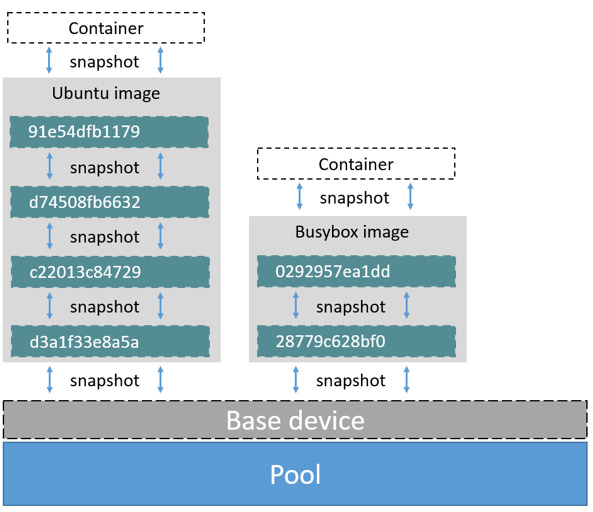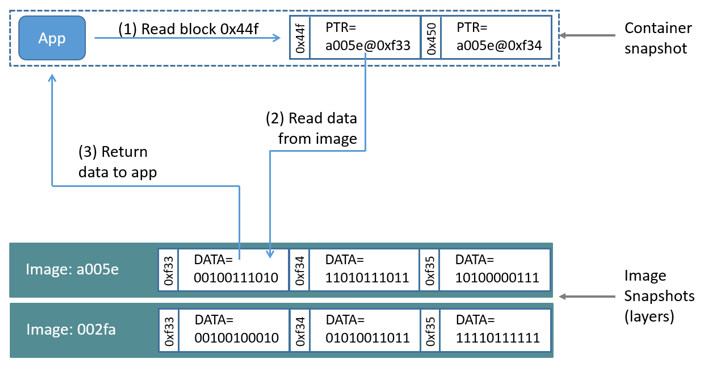devicemapper
Device Mapper是Linux系统中基于内核的高级卷管理技术框架。 它是内核中支持逻辑卷管理的通用设备映射机制,为实现块设备驱动提供了一个高度模块化的内核架构,包含三个重要的对象概念:Mapped Device、Mapping Table、Target device。
Docker的devicemapper storage driver基于该框架的thin-provisioning和snapshotting功能来实现对镜像和容器的管理。
Docker Engine的devicemapper使用专用块设备来存储数据而非文件系统。
devicemapper工作在block level,而不是file level。
块设备可以通过增加物理磁盘扩展。
How the devicemapper storage driver works
$ lsblk
NAME MAJ:MIN RM SIZE RO TYPE MOUNTPOINT
xvda 202:0 0 8G 0 disk
└─xvda1 202:1 0 8G 0 part /
xvdf 202:80 0 100G 0 disk
├─docker-thinpool_tmeta 253:0 0 1020M 0 lvm
│ └─docker-thinpool 253:2 0 95G 0 lvm
└─docker-thinpool_tdata 253:1 0 95G 0 lvm
└─docker-thinpool 253:2 0 95G 0 lvm
当使用devicemapper时,Docker把镜像和容器层的内容存储在thinpool中,然后mount到/var/lib/docker/devicemapper下的子目录上,以此把数据暴露给容器。
Image and Container Layers on-disk
/var/lib/docker/devicemapper/metadata目录包含关于Devicemapper配置本身和每个镜像和容器层的元数据。
devicemapper驱动使用snapshots,元数据信息包含snapshots。
文件是JSON格式的。
/var/lib/docker/devicemapper/mnt目录包含每个镜像和容器层的mount point。
镜像layer的mount points是空的,容器的mount point显示容器本身的文件系统,和从容器内部看是一样的。
Image layering and sharing
devicemapper使用block devices,而不是filesystems,它在块而不是文件这个层次操作。
SNAPSHOTS
devicemapper的另一重要特性是snapshots,有时也成为thin devices或者virtual devices;它仅仅存放每层之间的差异,非常轻量。
devicemapper workflow
当以devicemapper作为存储驱动时,关于镜像和容器的所有对象都存放在目录/var/lib/docker/devicemapper中,which is backed by one or more block-level devices, either loopback devices (testing only) or physical disks。
base device是lowest-level对象。这是thin pool本身。它包含一个文件系统。base device是每个镜像和容器层的起点。base deviceis a Device Mapper implementation detail, rather than a Docker layer.- 关于
base device和每个镜像/容器层的元数据以JSON格式存储在目录 /var/lib/docker/devicemapper/metadata/中。这些层都是copy-on-write snapshots。 - 每个容器的writable layer都被挂载到/var/lib/docker/devicemapper/mnt/下的一个mount point上。每个镜像层和不在运行的容器层都有一个空的目录。
每个镜像层都是它下面的镜像层的一个snapshot。镜像的最底层是base device的一个snapshot。运行一个容器,容器是对应的镜像的一个snapshot。

How container reads and writes work with devicemapper
Reading files
使用devicemapper,读操作at the block level。

容器中的应用发起了对块0x44f的读请求。由于container只不过是镜像的一个thin snapshot,所以它没有这个block,却有一个指针指向这个块——包含该块的最近的镜像层。容器从这里读取该块到容器的内存中。
Writting files
Writing a new file:往容器的中写数据由allocate-on-demand操作完成。文件的每个块都在容器的writable layer中分配,并将数据写入这些块。
Updating an existing file:只要相关的文件块才会拷贝到容器层,并不是所有的文件块。
Deleting a file or directory:当一个文件被删除后,devicemapper截获随后的读请求并返回文件不存在。
Writing and then deleting a file:If a container writes to a file and later deletes the file, all of those operations happen in the container’s writable layer. In that case, if you are using direct-lvm, the blocks are freed. If you use loop-lvm, the blocks may not be freed. This is another reason not to use loop-lvm in production。